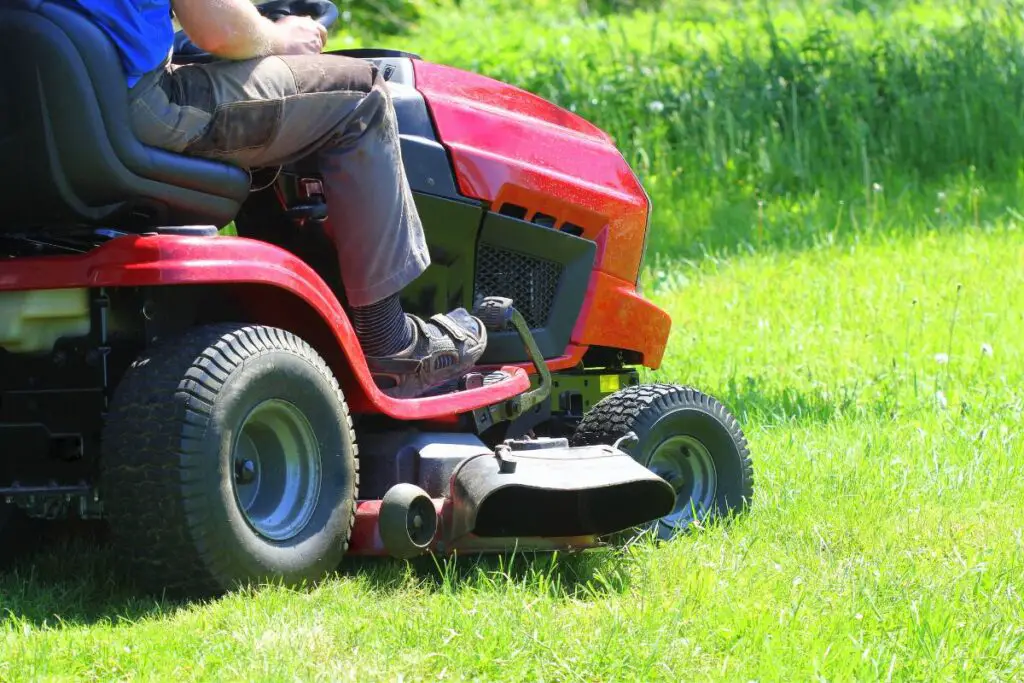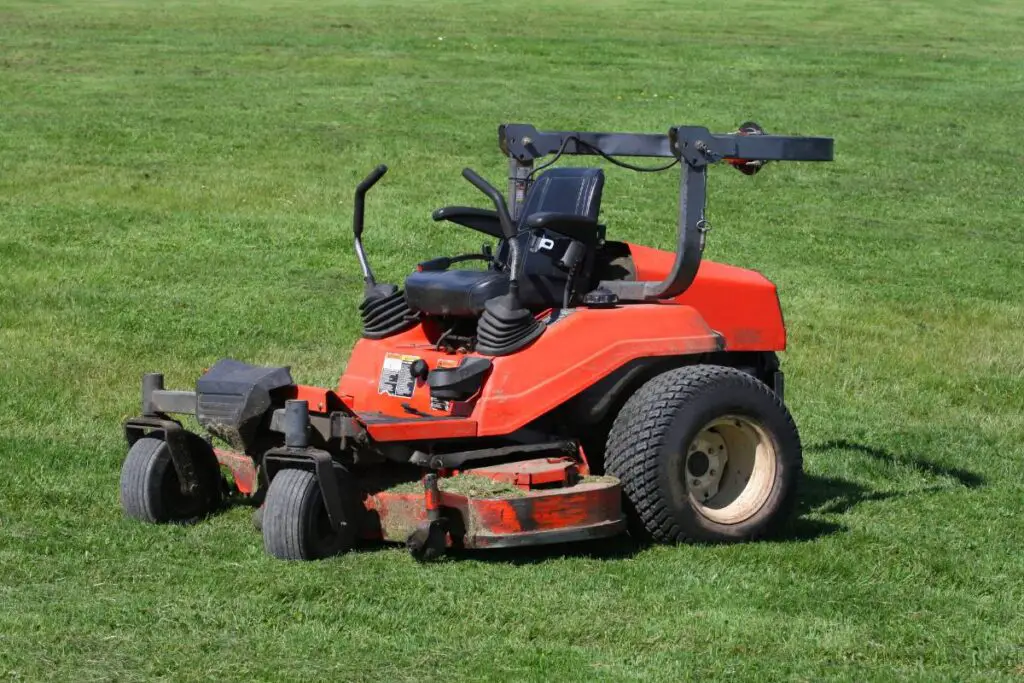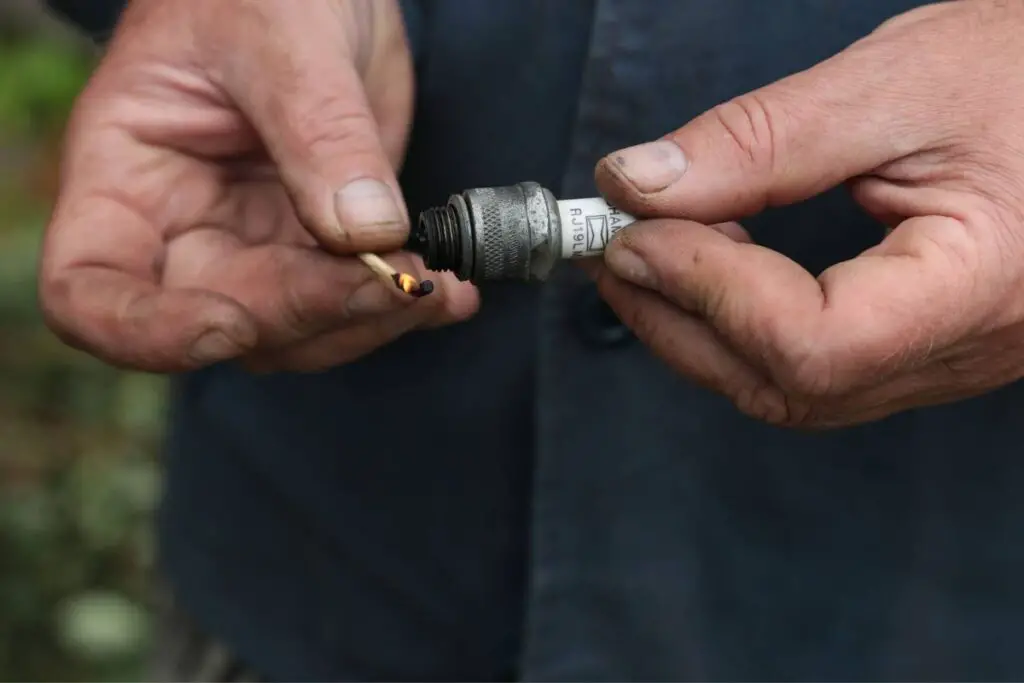Keeping the garden well-maintained becomes more manageable with a lawn mower. Preparing your mower for mowing only to find that it won’t start is frustrating. One of the most significant challenges could be a bad start.
Starting a lawn mower with a bad starter can be done using alternative methods such as a pull cord and jump-starting the battery. For a pull cord, remove the spark plug wire and slowly pull the cord. For jump-starting, connect the battery to a car battery using jumper cables.
Though you can start a mower with a bad starter, replacing it is best. This article provides a detailed guide about a bad starter: signs of a bad starter, how to understand the problem, and ways to start the mower with a bad starter.

What is a lawn mower starter?
The starter is a crucial part of the lawn mower.
It helps transfer the electricity from the battery to the mower’s ignition and starts the engine.
The starter contains two main parts:
- Starter solenoid: The starter solenoid receives current from the battery and transfers it into the motor. When you press the mower’s ignition button, the battery sends the current to the solenoid through the wiring, and then the current moves from the solenoid to the motor.
- Starter motor: The motor is the starter component connected directly to the mower’s spark plugs. The starter motor sends the electricity from the starter to the mower engine.
These two parts are separate inside the mower but work together to power the spark plug and generate a spark in the combustion chamber, providing power from the fuel.
Though these two parts are separate, the chain of passing power gets disturbed if one out of the two fails to work.
The engine won’t start when you turn on the ignition button.
But, there are still chances of getting the mower started by other alternatives.
Before you make any changes or repair the starter, you need to know whether the starter is the culprit or if there are other problems.
A lawn mower with a bad starter will have several symptoms to help you recognize the problem.
Read on to learn the signs.
Signs of a bad lawn mower starter
When the lawn mower rumbles after you start the engine, it is normal and indicates everything is correct.
But when you turn on the engine with a bad starter, the sounds are abnormal, and you can immediately understand the problem.
Here are some weird noises you will hear from the mower with a bad starter:
Abnormal solenoid clicking sound
When you turn on the ignition button of the mower, the solenoid will transmit the electric sparks to start the motor.
The motor will rotate a small gear of the engine.
This is how the engine will start.
When the process is normal, you will hear a clicking sound followed by some whirring sound indicating that the motor has engaged the engine.
But when you hear only the clicking sound after pushing the ignition button, something is wrong with the mower for which the motor is not engaging the engine.
Whirring sound but no catch
When you hear a whirring sound, you will also hear a loud rumbling sound which means that the starter is not engaging with the engine normally.
This sound indicates that the small gear in the starter is not correctly engaging with the engine’s gear.
Another sign is that when the engine starts, it will stop after some time.
The problem is usually broken teeth or worn-out motor brushes in the motor’s gear.
In such a condition, you have to replace the components.
Mower is not starting despite a fully charged battery
If the lawn mower does not start even with a fully-charged battery, the starter is the problem.
When this occurs, check for the problems immediately in the starter.
Looking for gardening supplies? We have tested 100's of products before recommending them to you guys. Check out our best pick below:
| Image | Gardening Supplies | Best Price? |
|---|---|---|
 Top
Top Top
Top | Raised Garden Bed Kit | Check On Amazon |
 | XLUX Soil Moisture Meter, Plant Water Monitor, Soil Hygrometer Sensor for Gardening, Farming, Indoor and Outdoor Plants, No Batteries Required | No Results |
 Top
Top Top
Top | 82 Pcs Garden Tools Set and Extra Succulent Tools Set | Check On Amazon |
 | Joeys Garden Expandable Garden Hose with 8 Function Hose Nozzle, Lightweight Anti-Kink Flexible Garden Hoses, Extra Strength Fabric with Double Latex Core, (50 FT, Black) | No Results |
 Top
Top Top
Top | Dual Chamber Compost Tumbler | Check On Amazon |
 Top
Top Top
Top | Sunnyglade Plant Stakes | Check On Amazon |
 Top
Top Top
Top | Organic Cold Pressed Neem Seed Oil | Check On Amazon |
 Top
Top Top
Top | Mighty Mint Gallon :-Insect and Pest Control Peppermint Oil | Check On Amazon |
 Top
Top Top
Top | Scotts DiseaseEx Lawn Fungicide | Check On Amazon |
 Top
Top Top
Top | Jacks Classic 20-20-20 All Purpose Fertilizer | Check On Amazon |
 Top
Top Top
Top | 30,000 Seeds Pollinator Attracting Wildflower Mixture | Check On Amazon |
 Top
Top Top
Top | Survival Vegetable Seeds Garden Kit-Over 16,000 Seeds | Check On Amazon |
Solenoid not clicking
As I said before, you should hear a clicking sound followed by a whirring sound after you push the ignition button.
When you do not even hear any clicking sound, it indicates a problematic starter.
Either the starter has been damaged, or there is a loose connection that is not allowing the current to reach the solenoid.
Tightening the loose connections can solve the problem, but damaged starters should be replaced.
These are some telltale signs behind a starter going bad.
Prior to proceeding, ensure to test the starter and confirm its defect.
How to check whether the starter has gone bad?
Every lawn mower will have the starter motor and the starter solenoid.
Though they work together, their positions are different in different mower models.
Check the manual and locate the solenoid following the battery’s red wire.
Rotate the ignition key.
If the solenoid works, but the motor doesn’t, you will hear a clicking sound from the solenoid.
When the starter is broken, you won’t hear anything.
Sometimes, the engine will stop working after a few seconds, or you hear only sounds, like clicking and whirring, but no engine sound.
These are some signs indicating that one of the starters has gone bad.
First, test which one is defective:
- Attach a jumper wire from the lug connecting the solenoid to the larger lug or motor. Start the engine.
- You have a defective solenoid if the engine starts from the bigger lug.
- If the mower still doesn’t start, attach the jumper to both the solenoid and motor.
- Now, turn on the mower again. If the mower doesn’t start, the entire starter needs a replacement.
- An alternative method to test the starter motor:
- Locate the starter motor near the engine’s side, especially in the riding lawnmowers, and test it with the battery.
- Use a jumper, connect the starter to the battery’s positive terminal, and put the screwdriver on the negative terminal.
- If the motor is good, it will rotate and sound fine. But if it makes weird noises, you have a defective motor.
Another way is by using an eliminator. Remove the starter motor and dismantle the upper part.
Put the positive and negative leads of the eliminator on the respective areas of the starter motor and test it.
If the starter has gone bad, replace it with a new one.
Sometimes, if only the solenoid is defective, you can wait to replace it.
The following section explains the methods of starting the mower despite having a bad starter.
Making impossible possible: Starting a lawn mower despite a defective starter
Sometimes, when the starter goes bad, you will only know if you use the mower.
If your starter has gone bad and you don’t have the option to fix it immediately, you can still start your lawn mower with the bad starter.
It is better to replace the starter if it has gone wrong and then use the mower.
Here are some proven methods to start a lawn mower despite a bad starter.
Bypassing the solenoid
Bypassing the solenoid when the solenoid is faulty is one of my favorite methods to start the lawn mower.
You can only choose this option if the solenoid motor is defective.
Despite working together, the solenoid and the starter motor will be separate components.
The solenoid will have some wire connections from the battery or the ignition switch.
To bypass the solenoid, connect these wires to the motor with metallic connections. Then start your mower.
You can still start the mower, even with a bad starter, if you hear a whirring sound. You have to try multiple times to start the mower.
Manually crank the pull cord
This is one of the best ways to start the lawn mower with a bad starter.
In the process, you need to remove the spark plug, attach a pull cord to the crankshaft of the mower, and pull the cord to rotate the engine and start combustion.
The process can be challenging.
So, it works best if done by an experienced mechanical person.
Before starting the lawn mower, take necessary precautions by wearing safety glasses and gloves and removing all flammable materials from the mower.
Here are the steps:
- Remove the spark plug wire from the spark plug of the mower.
- Locate the small hole in the crankshaft cover and attach a pull cord to the crankshaft.
- Ensure it is securely attached and positioned in the correct direction.
- Stand behind the mower firmly on the ground and extend your arms. This position will give you the leverage to pull the cord efficiently.
- Once you have attached it, hold the mower’s handle and pull the cord slowly until you hear the engine rotating.
- After that, the crankshaft will rotate to start the combustion. Once the engine rotates, leave the cord.
- The spark plug might be faulty if the mower does not start yet.
- Replace the plug and give it another try.
I once used this method, and the mower worked just fine. With the proper steps and precautions, you can also do it.
Here are some precautions you need to follow:
- Make sure that the mower is over a flat surface.
- The spark plug should stay disconnected at the start.
- The blades should not stay engaged while you are starting the process.
- The fuel should be off.
Jump-start method
If the mower does not start by the above method, try the jump-start method.
In this method, you need to connect the battery terminals to some external power sources.
Take necessary precautions before doing the work, like wearing goggles and gloves.
Make sure the external power source is turned off and disconnected initially.
Also, ensure the battery terminals are clean and free from dirt and corrosion.
Here are the steps:
- Take a jumper cable.
- Connect one cable end to the mower’s battery and the other to the external power source, such as a car battery or a wall outlet.
- Connect the red clamp of the external power source to the positive terminal of the mower battery and the black clamp to the negative terminal.
- After you have made the connection, start the power in the external power source.
- The electrical current from the external power source will jump-start the lawn mower.
I have never used this method but I saw one of my friends do it.
It is safe to use if done correctly.
Remember that a jump-start should be conducted as a last resort.
Take off the jumper cable from the battery as soon as possible.
Push-start method
This is very simple. You do not need any cables or cords for this.
This method physically pushes the mower while the ignition is turned ON.
- Ensure the mower’s ignition is ON and the choke is engaged.
- Stand behind the mower, in the position of pushing it.
- Apply downward pressure to the mower’s handlebars and engage the drive system.
- Start with pushing the mower briskly, slowly increase the speed, and release the pressure on the handlebars.
- The sudden pressure release will engage the mower’s drive system, and the wheels’ rotation will turn on the engine, eventually starting the mower.
Starting woes: Diagnosing and overcoming problems related to the starter

When the mower does not start, we first think of the starter.
If the starter goes wrong, the mower will not start.
Always the starter is not to be blamed.
There could be other reasons for which the starter may not respond.
So, the starter will start working as before after you solve the problem.
Let’s learn about them.
Battery problems
When your mower is not starting, check the battery once.
If the battery gets weak, it won’t be able to provide enough power to the starter to start the engine.
In such a condition, it is common to think the starter is faulty.
The first symptom you will have is a lack of cranking or slow crank.
The engine should click when you turn on the key or push the ON button.
If it doesn’t, the battery fails to send power to the starter to start the engine.
The battery should have the correct voltage.
The standard voltage is 12V; less than 12.4V means you will have a signaling issue.
If the voltage is the problem, replace the battery with a new one.
If you spot any leakages around the battery, fix them by covering them.
But replacement is the best option.
Charge the battery; if it works after that, it is fine, and you don’t have to replace it.
Get good-quality batteries for the mower that lasts longer.
Electrical wirings
The lawn mower turns on with gas, making enough heat to wear out the wire connections over time.
These wires are further connected to the starter and solenoid of the mower.
So, you need to check these wires if the mower engine is not starting.
Without these wires, the starters cannot send power to the engine to start.
These wires also connect the starter to the battery and ignition system.
Loose or damaged connections do not create sparks and fail to send power to the engines.
Open the lawn mower lid and clean the electrical connectors with a wire brush.
Make sure the wires are tightly connected; if not, tighten them.
If the wires have any wear outs and damages, get them replaced with the help of experts.
Faulty the ignition system
A faulty ignition system in the mower can create issues in the starter.
The switch will have cables that connect the ignition to the mower’s starter and the engine.
If these cables corrode, break, and damage, the mower cannot send power to the engine. As a result, it engine will not start.
The ignition switch damages can be beyond repair.
The best option is to replace the whole thing.
Dirty leads
The cables connected to the battery ensure that an adequate amount of electricity is passed into the battery so that the starters receive power to start the engine.
The cables should be clean and in stable condition.
There should not be tears or dirt and debris.
With clean cables, the electricity can pass smoothly without any interference.
Faulty or dirty Spark plugs

The starter motor is connected to the spark plugs to send power to the engine directly.
If the spark plugs are unclean and damaged, the starter will not receive any power to start the engine.
The spark plugs should be changed every 25 hours or before every mowing session.
It needs to be in perfect condition to perform its duty.
If the plug is damaged or worn out, replace it with a new one.
Your starter should start responding after this.
Binding starter motor
The start engine’s gear head can bind against the flywheel in the mower.
When this happens, the flywheel can lock the starter and the engine together.
As a result, there won’t be any clicking sound, and the mower won’t start.
To fix the problem, you must start the engine anti-clockwise by hand to unlock the starter and the engine.
Final Thoughts
The lawn mower has two starters: the starter motor and the starter solenoid. When the lawn mower’s starter is broken, replacing the whole starter is best. However, if you cannot do it right away, there are ways to use the mower with a defective starter. But in that case, the methods only work if the solenoid is faulty.
You can start the mower by bypassing the solenoid, manually cranking the pull cord, jump-starting with a jumper wire, and push-starting method. Sometimes, there are several other issues related to the starter. Still, people mistake the starter as faulty, for example, low battery, poor or loose wire connections, faulty ignition, dirty leads, and defective spark plugs.
Diagnose all these problems in detail and then jump to conclusions. If the starter is faulty, it is always better to get it replaced instead of using the alternative methods of starting the mower.
Will a lousy solenoid drain the battery of my lawn mower?
Usually, the lawn mower battery lasts for up to 2-3 years. But the solenoid does not drain your mower’s battery, as it attaches to the battery and starter cables.
What problems will a bad solenoid create?
Though you can start the mower with a bad solenoid, it is better to replace them. A bad solenoid leads to corrosion, breakage, and dirt.
Reference: Lawn Mower Wikipedia
